15 years one-stop China custom CNC machining parts factory
 95 |
Published by VMT at May 27 2025 | Reading Time:About 8 minutes
95 |
Published by VMT at May 27 2025 | Reading Time:About 8 minutes
Many industries rely on metal parts, but confusion often arises between two essential manufacturing processes—welding and metal fabrication. Customers frequently struggle to determine which process suits their project or product best.
Choosing the wrong process can lead to increased production costs, delayed timelines, or structural weaknesses in your final product. Misunderstanding the roles of welding and fabrication can prevent you from optimizing your design and manufacturing strategies.
This article demystifies the differences between welding and metal fabrication, explains each process in detail, and guides you through the technologies, advantages, disadvantages, and best use cases. Whether you're new to manufacturing or a seasoned engineer, this guide will help you make informed decisions and leverage the best CNC machining services for your needs.
Welding is a specific joining technique within the broader process of metal fabrication, which includes cutting, shaping, machining, and assembling metal parts. While welding fuses materials together, metal fabrication encompasses the entire journey from raw material to finished product, often involving metal CNC machining and other advanced techniques.
Understanding the distinction between welding and metal fabrication is vital for choosing the right process for your product development or part manufacturing. In the following sections, we’ll explore each concept in detail—starting with what metal fabrication actually involves. If you’re searching for precise solutions, our CNC machining services and metal fabrication expertise at VMT can help bring your vision to life.
Metal fabrication is the complete process of transforming raw metal into finished parts and products. It involves a series of operations including cutting, bending, assembling, and finishing to produce functional metal components. Whether the end use is automotive, aerospace, construction, or electronics, metal fabrication is a vital part of modern manufacturing.
This process begins with raw materials like sheet metal or metal bars. Through various techniques—manual or automated—the material is cut to size, formed into shapes, and joined together using mechanical fasteners or welding. Technologies like CNC machining play a key role in achieving high precision, consistency, and speed. CNC machining parts created during fabrication often serve as structural or functional elements in larger assemblies.
The versatility of metal fabrication lies in its adaptability. From simple brackets to complex enclosures and industrial machinery, the range of fabricated products is vast. At VMT CNC machining factories, we specialize in providing end-to-end metal fabrication services that integrate welding, CNC machining, and surface treatments for a streamlined production experience.
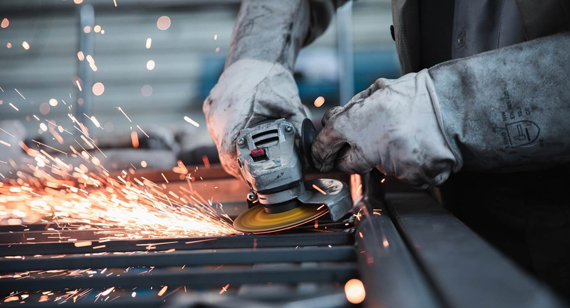
Yes, fabrication and manufacturing are different—but closely related—concepts. Understanding their differences is crucial for selecting the right service when developing metal parts or products.
Manufacturing is the broader term that refers to the entire process of producing finished goods from raw materials. It encompasses everything from planning and design to mass production using various methods and machinery. Manufacturing may involve a range of materials, including plastics, ceramics, composites, and metals, depending on the product being created. It includes processes like injection molding, 3D printing, assembly, machining, and more.
Fabrication, on the other hand, is a subcategory of manufacturing, specifically focused on metalworking. It involves the cutting, bending, welding, machining, and assembling of metal to create structures or components. In short, all fabrication is manufacturing, but not all manufacturing is fabrication.
For example, building a custom metal enclosure for an electronic device involves metal fabrication, as it includes sheet metal cutting, welding, and possibly metal CNC machining. But producing the full electronic device, including its circuit boards and plastic components, falls under manufacturing.
In today’s precision-focused industries, fabrication often overlaps with CNC machining services, especially when parts require exact tolerances or complex geometries. At VMT, we specialize in high-precision CNC machining parts and comprehensive metal fabrication services, ensuring your project benefits from both fabrication craftsmanship and advanced machining technologies.
This distinction helps customers identify whether they need a full-service manufacturing partner or a specialized fabrication provider like VMT CNC machining factories, where both processes can be seamlessly integrated under one roof.
Metal fabrication is a complex and highly specialized process that transforms raw metal into functional components or end-use products. From sheet metal to precision-engineered structures, a variety of technologies are employed throughout fabrication. Each technique offers specific advantages depending on the project requirements—such as accuracy, speed, or material strength. At VMT CNC machining factories, we utilize advanced metal CNC machining, cutting, and welding technologies to deliver high-quality CNC machining parts and comprehensive CNC machining services tailored to your needs.
Below is a breakdown of the most commonly used technologies in the metal fabrication process:
Plasma Cutting
Plasma cutting uses a jet of ionized gas at extremely high temperatures to cut through metal. It’s fast, precise, and works well with electrically conductive materials such as stainless steel and aluminum. This method is often chosen for custom metal fabrication and pre-machining processes.
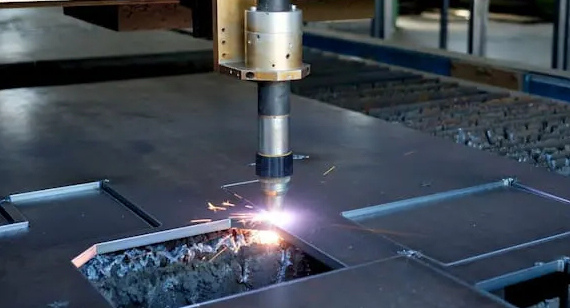
Casting involves pouring molten metal into a mold where it solidifies into a desired shape. It’s ideal for producing complex or large components and is commonly followed by CNC machining services for finishing. Stainless steel die casting is particularly popular in industries like automotive, aerospace, and medical.
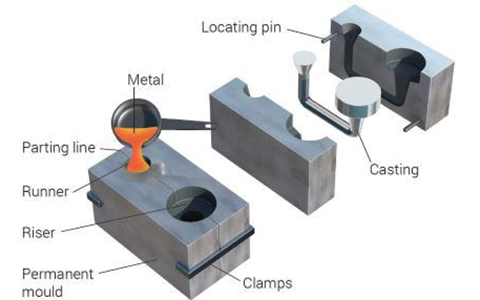
Forging
Forging shapes metal through the application of localized compressive forces, typically using a hammer or die. This process creates extremely strong parts due to the alignment of the metal grain. Forged components often undergo further machining to meet tight tolerances.
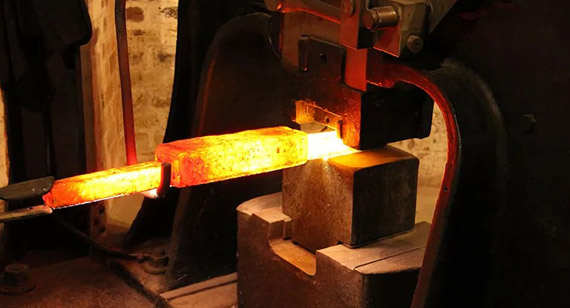
Stamping uses a die to press or shape metal into specific forms. It’s efficient for mass-producing parts like brackets, washers, and housings. While not as precise as metal CNC machining, stamping excels in speed and consistency.
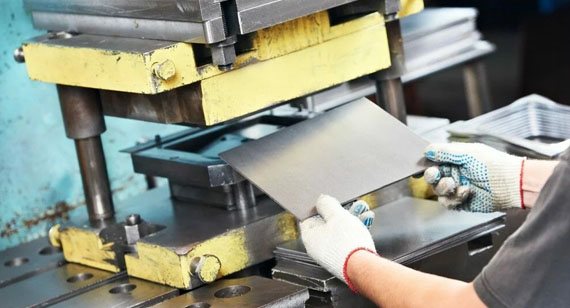
Wire Drawing
Wire drawing involves pulling metal through a die to reduce its diameter and increase its length. It’s widely used in producing electrical wiring and fine metal threads. This process ensures high tensile strength and dimensional accuracy.
CNC Milling
Milling is a subtractive CNC machining process that removes material using rotary cutters. It is essential for achieving high-precision geometries, such as slots, holes, and custom contours in CNC machining parts.
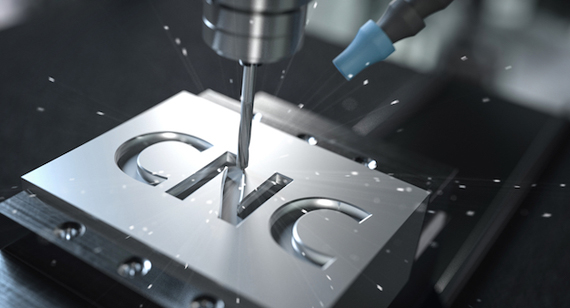
Turning rotates the workpiece while a cutting tool shapes the outer or inner surface, producing cylindrical parts such as shafts, bushings, and threaded components. At CNC machining factories, this process is key for efficient, accurate component production.
Extrusion
Extrusion forces metal through a die to create long, uniform shapes such as rods, pipes, or structural components. These extruded parts can then be cut and further processed through CNC machining or welding.
Drilling and Tapping
Drilling creates holes, and tapping adds threads to them. These are essential steps in assembling metal parts and are typically performed using CNC machining services for precise alignment and durability.
Bending
Bending reshapes flat metal sheets into angles, curves, or contours. Techniques like press braking or roll forming are used in structural fabrication and enclosure production. At VMT, we integrate CNC-controlled bending machines to enhance repeatability.
Polishing
Polishing improves the surface finish and appearance of metal parts, often required in consumer products or medical devices. It also helps reduce corrosion risks, especially in stainless steel components.
Shearing
Shearing cuts straight lines on sheet metal using a blade. It’s commonly used in the initial stages of metal fabrication before the parts undergo finer processes like milling, drilling, or welding.
Cutting
Beyond shearing and plasma cutting, cutting technologies include laser, waterjet, and saw cutting. These methods allow for high-speed and high-precision material separation and are crucial in preparing blanks for CNC machining or assembly.
By combining these technologies, metal fabrication achieves the structural integrity, detail accuracy, and surface quality required for modern industrial and consumer products. To learn more about how VMT integrates these processes into full-service solutions, explore our guide on welding vs. metal fabrication.
Here is a clear and professionally formatted table summarizing the metal fabrication technologies mentioned:
| Technology |
Description |
Common Applications |
| Plasma Cutting |
Uses ionized gas to cut through conductive metals with high speed and precision. | Sheet metal cutting, automotive parts, industrial components |
| Casting |
Molten metal poured into molds to form complex shapes. | Engine blocks, pump housings, stainless steel die cast parts |
| Forging |
Compresses metal using hammer or die to increase strength. | Aerospace parts, shafts, heavy-duty fasteners |
| Stamping |
Presses or punches metal into shapes using dies. | Brackets, washers, structural components |
| Wire Drawing |
Pulls metal through a die to reduce diameter and extend length. | Electrical wiring, springs, metal cables |
| Milling |
Rotating cutters remove material from a workpiece for high-precision shaping. | CNC machining parts, custom mechanical components |
| Turning |
Rotates the workpiece while a cutting tool removes material. | Shafts, bushings, threaded components |
| Extrusion |
Forces metal through a die to create long, uniform profiles. | Tubes, rods, structural rails |
| Drilling and Tapping |
Creates and threads holes in metal parts. | Assembly holes, threaded fasteners |
| Bending |
Deforms metal into angles, curves, or shapes using presses or rollers. | Enclosures, frames, structural brackets |
| Polishing |
Smooths and enhances surface finish for appearance and corrosion resistance. | Medical tools, consumer electronics, stainless steel parts |
| Shearing |
Straight-line cuts made on sheet metal using a blade. | Pre-processing for fabrication or CNC machining |
| Cutting |
Separates metal using laser, waterjet, saws, or blades for detailed shaping. | Blanks for CNC machining, decorative panels, industrial sheet parts |
Metal fabrication is the backbone of modern industry, enabling the transformation of raw metals into functional parts and products through various mechanical processes such as cutting, bending, welding, and CNC machining. Whether you're creating structural beams, customized enclosures, or intricate components for medical or aerospace use, metal fabrication is essential to achieving precision, performance, and durability. Understanding the strengths and limitations of this process can help engineers, product designers, and procurement professionals make informed decisions—especially when selecting a reliable CNC machining services partner or evaluating project feasibility.
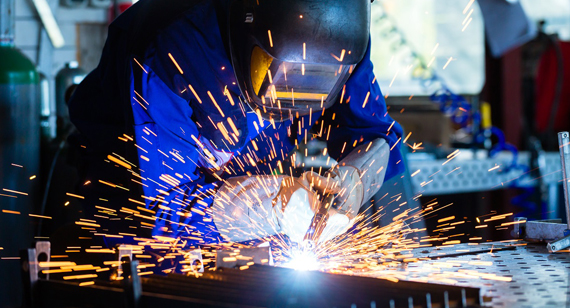
Advantages of Metal Fabrication
Metal fabrication offers numerous benefits that make it a preferred choice in industries such as aerospace, construction, automotive, and electronics:
Strength and Durability
Fabricated metal parts are often stronger and more durable than plastic or composite alternatives. Materials like stainless steel, aluminum, and titanium offer high tensile strength and are ideal for load-bearing applications. This durability ensures a longer service life and reduced maintenance over time.
Customization and Precision
With the support of advanced CNC machining services, metal fabrication can deliver highly customized parts with tight tolerances. CNC machining factories can produce intricate shapes and geometries consistently, making it ideal for prototyping and low-to-high volume production.
Versatility of Materials
A wide range of metals can be fabricated, including carbon steel, stainless steel, aluminum, brass, and copper. Each material offers unique properties, allowing manufacturers to select the most suitable option for the application.
Scalability and Efficiency
Modern fabrication techniques—especially when combined with automation and CNC machining—enable fast, repeatable production that scales well from prototyping to mass manufacturing.
Integration of Multiple Processes
Fabrication can include cutting, bending, welding, drilling, and even polishing—all performed in-house at advanced CNC machining factories, reducing lead times and cost.
Disadvantages of Metal Fabrication
While metal fabrication is highly beneficial, it comes with a few challenges that need to be considered:
Higher Initial Cost
Compared to plastic molding or 3D printing, the setup costs for metal fabrication, particularly when using CNC machines, can be higher. This includes tooling, machine programming, and material handling, which may be cost-prohibitive for very low-volume production.
Material Waste
Subtractive processes like milling and turning often result in material waste. Efficient planning and nesting strategies can help, but waste management is still a consideration, especially with expensive materials like titanium or copper.
Energy Consumption
Fabrication equipment, especially for heavy-duty welding or CNC machining, can consume significant energy. This not only impacts operating costs but also adds to the carbon footprint if not managed sustainably.
Complexity in Design for Fabrication
Not all product designs are fabrication-friendly. Engineers must understand the constraints of each fabrication process to avoid costly redesigns or production issues.
Skilled Labor Requirements
Metal fabrication often requires experienced technicians and machinists to operate equipment, especially for welding and manual CNC setup. This adds to labor costs and can be a bottleneck in
regions with a skilled workforce shortage.
Here's a clear and easy-to-understand table comparing the advantages and disadvantages of metal fabrication, tailored for CNC machining and industrial manufacturing audiences:
Table: Advantages and Disadvantages of Metal Fabrication
| Aspect |
Advantages |
Disadvantages |
| Strength & Durability |
Metal parts—especially those made from stainless steel, aluminum, or titanium—are highly durable, resistant to impact and wear, and suitable for structural or load-bearing applications. | May be heavier than alternatives like plastic or composites, potentially increasing shipping or structural costs. |
| Customization & Precision |
CNC machining services enable tight tolerances and highly customized CNC machining parts for all industries. Ideal for both prototypes and mass production. | Requires specialized equipment and skilled labor, increasing complexity and costs for certain designs. |
| Material Versatility |
A broad range of metals (e.g., carbon steel, aluminum, stainless steel) can be fabricated for specific application needs. | Some metals are expensive, and selection may be limited by available tooling or CNC machining capabilities. |
| Scalability & Efficiency |
Easily scaled with automation and CNC machining factories. High-speed production lines ensure consistent output. | Setup and changeover times can be long for small batches or highly customized runs. |
| Process Integration |
Processes like welding, bending, cutting, polishing, and drilling can be integrated in one workflow, reducing lead time. | Initial investment in full-service fabrication equipment or outsourcing to multiple vendors can be costly. |
| Cost Considerations |
Long-term durability and reusability can lower lifecycle costs despite higher upfront investment. | Higher initial costs compared to plastic molding or additive manufacturing. |
| Environmental Impact |
Metals are recyclable and fabrication can be optimized to minimize waste. | Subtractive processes (like CNC milling or turning) create scrap material, which must be recycled or disposed of. |
| Skill Requirements |
Skilled machinists and welders enhance quality and reduce errors, especially in custom projects. | Labor shortages or training gaps can slow production and affect output quality. |
Welding is a foundational process in metalworking that involves joining two or more pieces of metal by applying heat, pressure, or both. The purpose of welding is to create a strong, permanent bond that enables metal parts to act as a single, cohesive component—essential for structural integrity in a wide range of industries. Whether constructing skyscrapers, assembling vehicles, or manufacturing CNC machining parts, welding plays a critical role in modern engineering and manufacturing.
At its core, metal welding is not just about melting metals together; it’s about controlling heat, material compatibility, and joint strength. Depending on the application, different types of welding methods are used, such as TIG (Tungsten Inert Gas), MIG (Metal Inert Gas), Arc Welding, and Laser Welding. Each of these processes varies in terms of temperature range, filler materials, equipment complexity, and weld quality, offering flexibility across a wide range of materials and designs.
In CNC machining factories and metal CNC machining services, welding often complements other processes like cutting, bending, and turning. For example, after CNC machining a complex component, welding may be used to attach additional structural elements or reinforce stress-bearing zones. Welding and CNC machining services are frequently integrated into a complete production workflow, ensuring both precision and structural strength.
Metal welding is not limited to just steel or stainless steel—it can be performed on aluminum, titanium, nickel alloys, and more. For specialized applications like aerospace or medical devices, welding must meet strict industry standards and undergo thorough inspection, often involving X-ray or ultrasonic testing to ensure internal weld integrity.
In summary, metal welding is a versatile, essential process in metal fabrication, used to build, repair, and reinforce structures across virtually every industry. When paired with precision CNC machining services, it offers unparalleled performance, customization, and durability.
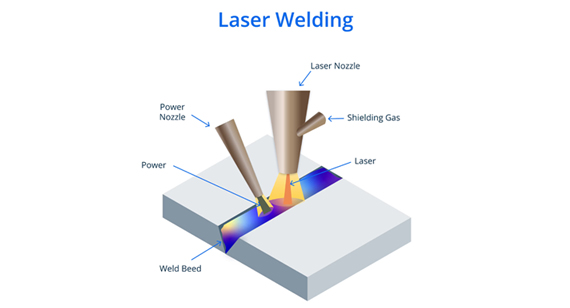
Metal welding works by fusing two or more metal parts together through the application of heat, pressure, or both—sometimes using a filler material to form a strong joint. The key objective is to create a permanent metallurgical bond between the materials, making them act as a single unit capable of withstanding mechanical stresses and environmental conditions.
There are three core principles in how welding works:
1. Heating the Base Materials
In most welding processes, heat is the primary driver for joining metals. This heat can come from various sources, such as:
The heat raises the temperature of the metal to its melting point, allowing the edges of each part to liquefy and form a weld pool.
2. Adding Filler Material (if needed)
Many welding methods use a filler metal to reinforce the joint. The filler is either fed automatically (like in MIG welding) or manually (as in TIG welding) and melts into the joint area, combining with the molten base metals to form a strong, unified structure.
In fusion welding, both the base and filler materials melt. In solid-state welding, no melting occurs; pressure and heat cause atomic diffusion at the interface.
3. Cooling and Solidification
Once the heat source is removed, the molten pool cools and solidifies. This creates a solid joint that is often stronger than the original metal. The cooling rate, weld pool geometry, and surrounding environment can all affect the quality and mechanical properties of the weld.
Welding in CNC Machining & Metal Fabrication
In metal fabrication and metal CNC machining, welding is commonly used in tandem with other processes like cutting, milling, and turning. After CNC machining parts to precise dimensions, welding may be used to assemble complex assemblies or reinforce structural elements.
For example:
Welding allows for the assembly of CNC-machined components into finished products, making it a critical part of CNC machining services and operations in CNC machining factories.
In conclusion, metal welding works by melting or pressing metals together to form a durable bond, often enhanced with filler material and refined cooling processes. When executed correctly, it produces reliable and often lifelong joints that are vital in manufacturing, construction, automotive, and countless other industries.
Welding plays a vital role in modern manufacturing, construction, and engineering by enabling the permanent joining of metals to build everything from skyscrapers and bridges to precision parts in CNC machining. But why exactly do we weld? The answer lies in the unique benefits welding offers over other joining methods like bolting, riveting, or adhesive bonding.
1. To Create Permanent, High-Strength Joints
One of the primary reasons for welding is the need for strong, durable connections that behave like a single piece of metal. Unlike mechanical fasteners, welds do not weaken the material by drilling holes, and they eliminate the risk of parts loosening over time. This is critical for high-load, high-pressure, or high-temperature applications such as:
2. To Enable Customization and Complex Assemblies
Welding allows engineers and fabricators to design complex shapes and assemblies that would be impossible to manufacture as a single part. For example, metal CNC machining can produce precision components, and welding can then join these pieces into larger structures without sacrificing performance or dimensional accuracy.
Applications include:
3. To Improve Cost Efficiency
In many cases, welding is more cost-effective than casting or machining a large part from a single metal block. By welding smaller, simpler components, manufacturers save on:
This is especially true in CNC machining services, where combining machined parts via welding can dramatically reduce overall production costs while maintaining structural integrity.
4. To Repair or Reinforce Existing Metal Structures
Welding is indispensable for repair work in industries such as construction, transportation, and manufacturing. Cracks, breaks, or worn-down sections in metal structures can be repaired with welding, restoring them to full strength without the need for full replacement.
It’s also widely used for:
5. To Maintain Seamless, Leak-Proof Assemblies
In industries like petrochemical, plumbing, and food-grade equipment, welding ensures leak-proof joints that are free from gaps or seams. This is crucial for transporting gases, liquids, or even handling sterile materials, where any leak or contamination could lead to failure or health risks.
6. To Support Innovation in Fabrication
As new materials, techniques, and automation emerge—especially in CNC machining factories—welding continues to support innovation. From laser welding in microelectronics to robotic welding in automotive manufacturing, the process keeps evolving to meet the needs of modern design and functionality.
Final Thought
We weld because it’s the most reliable, efficient, and flexible way to join metal in everything from small CNC-machined parts to massive structural components. It’s the backbone of metal fabrication, enabling innovation and performance across industries. Whether you're building a bridge or assembling a custom part in a CNC machining service, welding is an essential process that ensures safety, strength, and success.
Welding is not a one-size-fits-all solution—there are numerous welding methods, each designed for specific applications, materials, and conditions. In the world of metal fabrication and metal CNC machining, choosing the right welding technique is critical to ensuring quality, strength, and efficiency. Below is a breakdown of the most common types of welding used across industries, from aerospace to construction and CNC machining factories.
Fusion Welding
Fusion welding is the most common form of welding, involving the melting of base materials—and often filler material—to join metals. It includes techniques like MIG, TIG, and arc welding. Heat is applied directly to the joint, melting the materials, which then solidify into a strong bond. Fusion welding is highly effective for joining thick sections and dissimilar metals, and it’s widely used in structural components, heavy machinery, and CNC-machined parts assembly.
Solid State Welding
Unlike fusion welding, solid-state welding joins metals without melting them. Instead, pressure, heat, or both are applied to bond materials at the molecular level. Common types include friction welding and ultrasonic welding. Solid state welding is ideal for dissimilar or heat-sensitive materials and offers minimal distortion—perfect for precision parts in CNC machining services.
Manual Metal Arc Welding (SMAW)
Also known as stick welding, SMAW is a versatile and portable method commonly used in construction and repair. It involves a consumable electrode coated in flux, which produces gas to shield the weld. Though more manual than other types, it's excellent for outdoor environments and heavy-duty tasks, such as structural fabrication or on-site CNC component welding.
Oxyacetylene Welding (OA)
Oxyacetylene welding uses a combination of oxygen and acetylene gases to produce a flame hot enough to melt steel. It’s one of the oldest welding methods and is often used for repairing pipelines, cutting metal, and welding thin steel sheets. While slower than modern methods, it's still a valuable tool in small-scale metal fabrication and emergency repair work.
Tungsten Inert Gas Welding (TIG)
TIG welding, or GTAW (Gas Tungsten Arc Welding), uses a non-consumable tungsten electrode and inert gas (usually argon) to protect the weld. It allows for precise, high-quality welds with clean finishes, making it ideal for CNC-machined stainless steel parts, aerospace components, and thin materials. TIG is preferred for aluminum, magnesium, and non-ferrous metals.
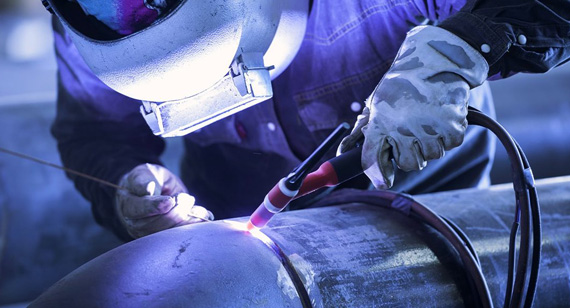
Gas Metal Arc Welding (MIG)
MIG welding, or GMAW, uses a consumable wire electrode fed through a gun, which melts and joins the base metals under a shielding gas. It’s fast, easy to automate, and perfect for high-volume fabrication, such as automotive manufacturing, sheet metal work, and CNC machining factories producing large parts. It offers a balance of speed and quality.
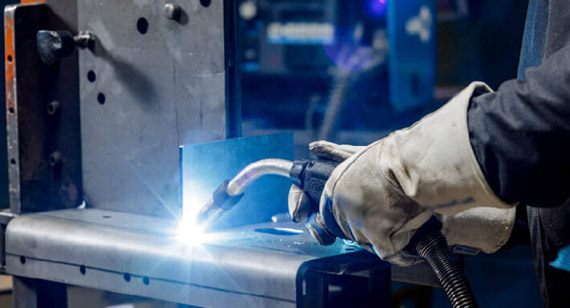
Brazing
Brazing is a low-temperature process where a filler metal is melted and drawn into the joint by capillary action without melting the base metals. It's excellent for joining dissimilar metals, thin parts, or delicate assemblies. Brazing is common in HVAC systems, electronics, and custom CNC assemblies requiring clean, strong joints without distortion.
Flux Cored Arc Welding (FCAW)
FCAW is similar to MIG but uses a flux-filled wire, eliminating the need for external shielding gas. It works well outdoors or in windy environments and provides deep penetration, making it useful in structural steelwork and heavy machinery fabrication. It's often used where speed and mobility are required.
Plasma Arc Welding
Plasma arc welding is a high-precision welding method that uses a focused plasma arc to melt metal. It’s capable of extremely fine welds, often used in aerospace, medical equipment, and CNC precision parts. Plasma welding produces minimal distortion, making it ideal for thin and complex components.
Submerged Arc Welding (SAW)
SAW involves an arc formed beneath a blanket of granular flux, protecting the weld from contamination. This method is highly productive and creates deep, high-quality welds with minimal spatter. It’s best suited for long, linear welds on thick materials, such as tanks, pipelines, and ship hulls.
Laser Beam Welding (LBW)
LBW uses a high-powered laser beam to fuse materials quickly and accurately. It's widely used in automotive, aerospace, and CNC micromachining where high precision is key. Laser welding creates narrow, deep welds with low heat input, reducing distortion and making it perfect for thin or intricate parts.
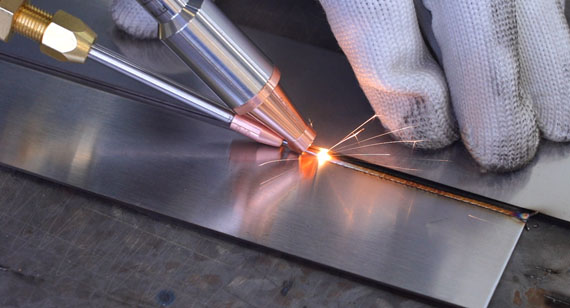
Here’s a structured table summarizing the Different Types of Welding, suitable for a professional CNC machining and metal fabrication context:
| Welding Type |
Description |
Key Features & Applications |
| Fusion Welding |
Melts base materials to join metals, often using filler material. | Strong joints, suitable for thick metals; used in structural parts, CNC machining assemblies. |
| Solid State Welding |
Joins metals without melting by applying pressure and heat. | Minimal distortion, good for dissimilar/heat-sensitive metals; ideal for precision CNC parts. |
| Manual Metal Arc Welding (SMAW) |
Uses consumable electrode coated with flux to shield weld area. | Portable, versatile; widely used in construction and repair work. |
| Oxyacetylene Welding (OA) |
Uses oxygen and acetylene gases to create flame for melting metals. | Traditional method; used in repair, cutting, and thin sheet welding. |
| Tungsten Inert Gas Welding (TIG) |
Uses non-consumable tungsten electrode and inert gas shield. | Precise, high-quality welds; ideal for stainless steel, aluminum, thin metals. |
| Gas Metal Arc Welding (MIG) |
Uses consumable wire electrode and shielding gas for continuous welding. | Fast, easy to automate; common in automotive and large-scale fabrication. |
| Brazing |
Filler metal melts and joins without melting base metals. | Joins dissimilar metals; used in HVAC, electronics, delicate CNC assemblies. |
| Flux Cored Arc Welding (FCAW) |
Similar to MIG but with flux-filled wire, no external shielding gas needed. | Good for outdoor/windy environments; used in heavy machinery and structural steelwork. |
| Plasma Arc Welding |
Uses a focused plasma arc for precise melting. | High precision, minimal distortion; used in aerospace and CNC precision parts. |
| Submerged Arc Welding (SAW) |
Arc formed under granular flux blanket to protect weld. | High productivity, deep welds; used for pipelines, tanks, and shipbuilding. |
| Laser Beam Welding (LBW) |
Uses a high-powered laser beam for rapid, accurate fusion. | Narrow, deep welds with low heat; perfect for automotive, aerospace, and micromachining. |
Here’s a clear and concise table summarizing the Key Advantages and Disadvantages of Metal Welding, designed for professional CNC machining and metal fabrication contexts:
| Category |
Details |
| Introduction |
Metal welding is a fundamental process in metal fabrication and CNC machining, enabling the permanent joining of metal parts. It plays a critical role in manufacturing durable, precise, and complex assemblies used across industries. Understanding its benefits and limitations helps optimize production and product quality. |
| Advantages of Metal Welding |
- Strong and Durable Joints: Welding creates robust bonds that can withstand high stress and load. - Versatility: Applicable to various metals and alloys, including steel, aluminum, and stainless steel. - Cost-Effective: Reduces the need for mechanical fasteners and enables efficient assembly. - Flexibility in Design: Allows fabrication of complex shapes and structures that are difficult to achieve with other joining methods. - Speed: Modern welding techniques enable fast production cycles, enhancing manufacturing throughput. - Integration with CNC Machining: Welding complements CNC machining parts assembly for precision and performance. |
| Disadvantages of Metal Welding |
- Thermal Distortion: Heat from welding can cause warping or deformation, affecting precision parts. - Skilled Labor Required: Effective welding demands trained operators to ensure quality and safety. - Material Limitations: Some metals or thin materials may be challenging to weld without defects. - Safety Hazards: Welding involves high temperatures, UV radiation, and fumes, requiring strict protective measures. - Post-Weld Treatment: Often requires grinding, cleaning, or heat treatment to enhance appearance and mechanical properties. |
Process Comparison
Welding and fabrication are interrelated but fundamentally different steps within the metalworking industry. While welding focuses on joining metal parts, fabrication involves a broader scope, encompassing cutting, shaping, assembling, and finishing metals. Understanding each process will enable better coordination in CNC machining factories and optimize your product’s quality and efficiency.
Metal Welding Processes
Welding is the process of permanently joining metals using heat, pressure, or both. Common metal welding processes include:
These processes create strong joints essential for structural integrity in CNC machining parts and assemblies.
Fabrication Processes
Fabrication involves multiple steps that transform raw metal materials into finished products. It includes:
Fabrication covers the entire lifecycle from raw material to the final product, ensuring parts meet precise specifications and functional requirements.
Equipment and Skills Required
The equipment and expertise necessary for welding versus fabrication differ significantly. Knowing these distinctions helps clients understand project complexity and workforce demands.
Metal Welding
Welding requires specialized equipment such as arc welders, welding guns, and shielding gas supplies. Skilled welders must master techniques to avoid defects like porosity or cracking, ensuring weld strength and durability in CNC machining parts.
Fabrication
Fabrication demands a broader range of machinery, including CNC milling machines, lathes, shears, press brakes, and welding stations. Fabricators need multidisciplinary skills—reading blueprints, operating CNC machines, metal cutting, and assembly—all vital for producing quality metal parts.
Cost and Time Impacts
Welding and fabrication impact production costs and schedules differently, which influences project planning and budget control.
Metal Welding
While welding can be fast and efficient, complex welds or high-quality requirements may increase labor and inspection costs. It is essential in joining CNC machining parts but can add to post-processing time if additional finishing or quality checks are needed.
Fabrication
Fabrication typically involves longer lead times due to multiple steps, including cutting, machining, and assembly. However, streamlined CNC machining services and automated fabrication lines can reduce costs and accelerate delivery for large volume production.
Applications
Each process serves unique functions across industries, shaping their use in manufacturing and CNC machining services.
Metal Welding
Welding is indispensable for structural frameworks, automotive parts, aerospace components, and metal assemblies where permanent, strong joints are critical.
Fabrication
Fabrication suits a wider range of applications—from custom CNC machining parts to architectural metalwork, industrial machinery, and consumer appliances—requiring precision and versatility.
Here is a clear and professional comparison table outlining the Key Differences Between Welding and Fabrication, designed for readers in CNC machining, manufacturing, and metalworking industries:
Welding vs. Metal Fabrication: Comparison Table
| Category | Welding | Metal Fabrication |
| Definition | A metal joining process that fuses materials using heat, pressure, or both. | A complete process of cutting, shaping, assembling, and finishing metal parts. |
| Primary Purpose | To permanently join two or more metal components. | To build complete parts or assemblies from raw metal materials. |
| Processes Involved | SMAW, MIG, TIG, FCAW, LBW, etc. | Cutting, bending, milling, turning, drilling, welding, polishing, etc. |
| Equipment Used | Arc welders, welding torches, shielding gas systems, PPE | CNC machines, shears, press brakes, lathes, milling machines, welders, etc. |
| Skill Requirements | High-level expertise in welding techniques and metal joint integrity. | Broader skill set: blueprint reading, CNC machining, welding, assembly, finishing. |
| Typical Applications | Structural frameworks, pipelines, auto bodies, aerospace parts | Machinery, sheet metal components, enclosures, CNC machining parts |
| Cost Factors | Generally lower upfront cost, but labor-intensive for complex welds. | Higher initial cost due to multiple operations, but cost-effective in mass production. |
| Time Requirements | Faster for joining tasks; may require post-weld processing. | Longer process due to multiple steps; efficient when automated. |
| Material Flexibility | Ideal for ferrous and non-ferrous metals. | Applicable to a wide range of materials: steel, aluminum, copper, brass, etc. |
| Role in CNC Machining | Used in assembly of CNC machining parts and prototypes. | Encompasses the entire production process of CNC machining services. |
This table helps readers quickly grasp how welding and metal fabrication differ in purpose, scope, and execution, aiding in decision-making for CNC machining services and manufacturing needs.
Metal fabrication isn’t just about cutting and welding—it’s a structured, multi-phase process that turns raw metal into finished products used across industries such as automotive, aerospace, medical, and electronics. Whether it’s a small custom bracket or a complex CNC-machined assembly, each project moves through three core stages: bidding, planning, and production. Understanding these steps helps customers choose reliable metal CNC machining services and avoid unnecessary delays or costs. At VMT, we guide every client through these processes with professionalism, transparency, and technical excellence to ensure parts are made precisely to specification.
Bidding
The bidding phase is where communication begins. A customer submits their drawings, 3D models, material preferences, and volume requirements. Based on this information, the fabrication company—such as a CNC machining factory like VMT—reviews all technical aspects, determines manufacturability, selects the optimal machining or fabrication methods (like turning, milling, or welding), and provides a quote. This quote includes pricing, lead time, machining processes, and potential suggestions for design improvements to reduce cost or enhance function. A well-executed bidding process builds trust and sets the tone for a successful partnership.
Planning
Once the quote is accepted, the project enters the planning stage. Here, engineers and production managers define how to manufacture each component. This includes creating process flow charts, selecting tools and machines (CNC milling, metal welding, etc.), ordering materials, and scheduling production. For complex assemblies, this may also involve creating jigs, verifying tolerances, and assigning skilled welders or machinists. Accurate planning minimizes waste, reduces downtime, and ensures that delivery timelines are met—an essential advantage when choosing CNC machining services for metal parts.
Production
The production phase is where the metal fabrication truly begins. Raw metal is cut, formed, machined, and assembled according to the project’s specifications. CNC machining plays a key role here, delivering consistent, repeatable accuracy on every part. Skilled operators perform milling, turning, drilling, tapping, and welding as needed. Quality control teams inspect each stage, using CMM machines, gauges, and visual inspections to ensure the product meets or exceeds expectations. Once approved, parts are packaged and shipped, ready to be integrated into the customer’s application—whether it's automotive, medical, or marine use.
In welding and metal fabrication, tools are the backbone of quality craftsmanship. Whether creating custom CNC machining parts or fabricating complex structures, the right tools ensure precision, safety, and efficiency. From manual instruments like hammers and wrenches to advanced systems like laser cutters and CAD software, each tool plays a specific role in transforming raw metal into engineered components. At VMT, we integrate traditional hand tools with advanced CNC machining services to offer accurate, high-performance metal parts across industries.
Abrasives
Abrasives are essential for cleaning welds, smoothing rough edges, and preparing surfaces for finishing. They include grinding wheels, sanding discs, and wire brushes. In fabrication, abrasives ensure weld seams are smooth and safe, which improves the aesthetic and structural integrity of metal CNC machining parts.
Adjustable Wrenches
These versatile tools are used to tighten and loosen nuts, bolts, and other fasteners during assembly or setup. Adjustable wrenches are essential for fitting and securing components during both manual fabrication and post-machining assembly.
Angle Grinders
Angle grinders are used for cutting, grinding, and polishing metals. They're vital in welding preparation and cleanup. In metal fabrication shops, angle grinders provide the flexibility to trim, deburr, or fine-tune parts before final inspection or shipping.
Arc Welders
Arc welders use electricity to create intense heat and fuse metal parts. They’re fundamental in joining steel and stainless steel, especially in structural or load-bearing applications. Arc welding supports the production of strong, durable components in CNC machining and fabrication projects.
Pipe Benders and Breakers
Used to bend pipes or tubing to precise angles, these tools are essential in HVAC, automotive, and construction applications. Pipe benders are often combined with CNC machined fittings to create accurate assemblies.
Chipping Hammers
Chipping hammers are used to remove slag from welds. After arc welding, excess residue can remain, and chipping hammers help clean and expose the solid weld beneath, ensuring better quality control in fabricated assemblies.
Computers and CAD Software
CAD software is a modern essential in metalworking. It allows for the digital design of CNC machining parts and complex welded structures. These files guide CNC machines and help plan precise welding fixtures and cutting operations, ensuring zero tolerance errors.
Consumable Electrodes
In welding, electrodes are critical for completing the electrical circuit and transferring filler metal to the joint. Consumable electrodes are used in MIG and stick welding, directly affecting weld quality and consistency.
Laser and Waterjet Cutters
These high-precision tools use laser beams or high-pressure water streams to cut metals with minimal waste and deformation. They're often used before CNC machining or welding processes, especially for stainless steel or aluminum.
Oxygen and Acetylene Tanks
Used in gas welding and cutting, these tanks supply fuel to create high-temperature flames. Oxy-acetylene welding is particularly useful for repair work or when portability is required in remote metal fabrication settings.
Shears
Shears are industrial scissors used to make straight cuts in sheet metal. They’re ideal for preparing blank stock before welding or CNC machining. Hydraulic shears can handle thicker materials with higher force and consistency.
Talc
Talc is sometimes used in welding as a marking compound because it’s visible on metal and resists heat. Welders use it to sketch layouts, cutting lines, or welding points without smudging.
Vises and Vise Clamps
Vises hold parts firmly during cutting, welding, grinding, or assembly. They are crucial for safety and precision, especially when working with custom CNC machined parts or small metal components.
Welding Fixtures
Fixtures are custom jigs or setups used to hold workpieces in place during welding. They improve repeatability, alignment, and weld consistency—especially in high-volume CNC machining factories and fabrication environments.
Here's a clear and organized table of Welding and Metalworking Tools, summarizing each tool's function and its relevance in metal fabrication, welding, or metal CNC machining processes. This table enhances readability for your article section:
Welding and Metalworking Tools Table
| Tool Name |
Function |
Application in Welding & Metal Fabrication |
| Abrasives |
Used to smooth, grind, or clean metal surfaces. | Essential for surface preparation before and after welding or CNC machining. |
| Adjustable Wrenches |
Tighten or loosen bolts of various sizes. | Common in manual assembly and maintenance during fabrication setups. |
| Angle Grinders |
Cutting, grinding, and polishing metal edges. | Useful in finishing welded joints and cleaning CNC machined surfaces. |
| Arc Welders |
Generate heat to melt and fuse metal using an electric arc. | Core equipment for all arc welding processes such as SMAW or MIG. |
| Pipe Benders and Breakers |
Bend pipes and tubing to desired angles or break them cleanly. | Crucial in structural and piping fabrication involving CNC-formed components. |
| Chipping Hammers |
Remove slag after welding. | Ensures clean welds and prepares surfaces for inspection or finishing. |
| Computers & CAD Software |
Design parts and control CNC machines. | Used in metal CNC machining to program precision operations and fabrication layouts. |
| Consumable Electrodes |
Provide filler metal for welding and conduct current. | Vital in processes like SMAW, FCAW, and MIG welding. |
| Laser & Waterjet Cutters |
Cut metal using high-precision beams or water streams. | Preferred for CNC-level accuracy and complex geometries in sheet metal fabrication. |
| Oxygen & Acetylene Tanks |
Fuel source for gas welding and cutting. | Used in OA welding for heating and cutting thicker metals. |
| Shears |
Cut metal sheets and plates cleanly. | Employed in pre-machining material preparation in CNC machining factories. |
| Talc |
Marking tool used for layouts on metal surfaces. | Helps outline designs or weld locations before fabrication or machining. |
| Vises & Vise Clamps |
Hold workpieces securely during fabrication or welding. | Ensures accuracy and safety during CNC machining or welding setups. |
| Welding Fixtures |
Align and hold parts in place during welding. | Critical in batch welding processes to ensure consistency and strength. |
In the world of metal fabrication, welding, and CNC machining services, safety isn’t optional—it’s essential. Personal Protective Equipment (PPE) is the frontline defense for workers handling heavy machinery, high temperatures, sharp metals, and toxic fumes. Whether fabricating a structural steel frame or precision CNC machining parts, proper PPE prevents injuries, ensures compliance, and boosts productivity by allowing operators to focus confidently on their work. At VMT, every project starts with safety, and we ensure that our team is equipped with the right gear for every task.
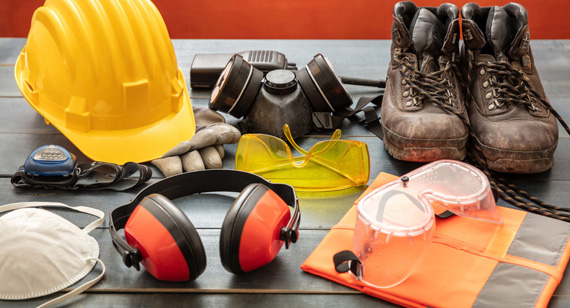
Eye Protection
The eyes are highly vulnerable in welding and machining environments. Sparks, UV radiation, metal shards, and chemical splashes pose serious risks. Safety glasses with side shields, welding goggles, and auto-darkening helmets are all vital. In CNC machining, high-speed cutting and drilling can send chips flying, making impact-resistant glasses a must. VMT mandates certified eye protection in all active work zones to protect vision and ensure safe operation across all stages of production.
Hearing Protection
Continuous exposure to loud machinery—like grinders, welding equipment, or CNC milling machines—can lead to permanent hearing damage. Earplugs and earmuffs are standard hearing protection tools that reduce noise exposure to safe levels. In a CNC machining factory, where multiple machines run simultaneously, VMT supplies employees with noise-canceling earmuffs that ensure focus and comfort throughout their shifts.
Face Protectors and Goggles
Face shields and welding helmets are used to protect the entire face from sparks, splatter, and radiant heat. While goggles shield the eyes, face protectors are critical during heavy grinding, plasma cutting, or TIG/MIG welding, where flying debris or arcs are common. Our team at VMT uses modern face protection gear with adjustable fits and anti-fog coatings to maintain visibility and safety in high-precision operations.
Respirators
Welding fumes, machining dust, and fine particles from grinding can pose respiratory hazards. Respirators are worn to filter out airborne contaminants and ensure a clean breathing environment. Depending on the task, workers may use disposable masks, half-face respirators, or powered air-purifying respirators (PAPRs). At VMT, we implement strict air quality controls and provide respirators that meet industry standards to safeguard respiratory health during long-term metal CNC machining and fabrication work.
Leather Gloves and Aprons
Heat, sharp edges, and metal burrs require tough hand and body protection. Heavy-duty leather gloves offer heat resistance and protect against cuts and abrasions, while leather aprons shield the body from sparks and molten splatter. Fabrication and welding demand both dexterity and protection, which is why VMT provides ergonomically designed gloves that allow precise handling of CNC machined parts without compromising safety.
Safety Shoes
Feet are often exposed to falling tools, heavy components, or molten metal. Steel-toe or composite-toe safety shoes are required in all metalworking environments. Anti-slip soles and puncture-resistant midsoles are also essential when working with sharp scraps or greasy floors. At VMT, all employees working on-site in machining or welding zones wear certified safety footwear to reduce the risk of foot injuries.
High Visibility Clothing
In busy workshops or large CNC machining factories, being seen is critical. High visibility vests, jackets, or uniforms improve worker awareness and prevent accidents, especially in areas where forklifts or cranes are operating. Reflective clothing is a basic but vital safety measure, particularly during night shifts or in dimly lit production facilities.
When precision, quality, and efficiency matter most, VMT stands as a trusted leader in welding and metal fabrication machining services. With years of hands-on experience and a facility equipped with advanced CNC machining factories, we provide end-to-end solutions for diverse industries—from automotive to aerospace, medical, electronics, and beyond.
One-Stop CNC Machining and Fabrication Services
At VMT, we specialize in delivering comprehensive CNC machining services that integrate seamlessly with welding and metal fabrication processes. Whether you're developing a prototype or need mass production, we offer a full suite of services:
By combining traditional metal fabrication expertise with precision-driven metal CNC machining, we ensure the highest levels of accuracy, strength, and aesthetic quality.
Industry-Leading Technology and Capabilities
Our machining factory is equipped with:
This technology allows us to handle tight tolerances, complex geometries, and a wide variety of materials—including aluminum, stainless steel (304, 316, 316L), carbon steel, and specialty alloys.
Why Choose VMT?
Whether you're looking for custom CNC machining parts, metal welding services, or fabrication of functional assemblies, VMT delivers value through precision, performance, and partnership.
Ready to Start Your Project?
Join hundreds of global clients who trust VMT for reliable CNC machining and metal fabrication services. Contact us today to get a free quote or learn how we can support your next manufacturing project.
For more insights into our service capabilities, explore:
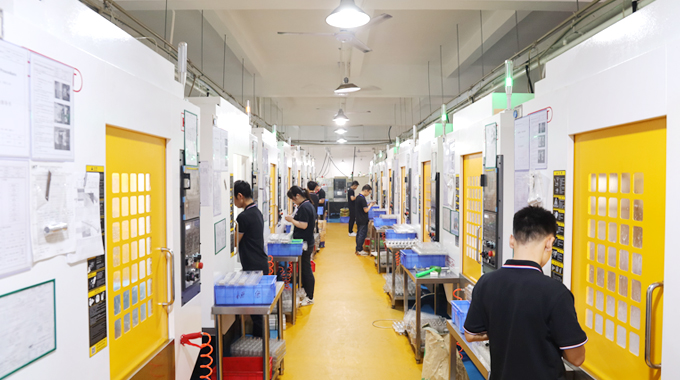
Understanding the difference between welding and metal fabrication is essential for selecting the right process for your project. While metal fabrication encompasses a broad range of processes—cutting, bending, shaping, and assembling metal parts—welding is a specialized technique within that scope, used to permanently join metal components.
Each process offers distinct advantages: fabrication allows for complex, multi-step production tailored to precision and functionality, while welding delivers strength and structural integrity in critical applications. Your choice depends on factors such as design complexity, material type, production volume, and end-use requirements.
At VMT CNC Machining Factory, we combine deep expertise in both metal CNC machining and fabrication and welding services. From prototyping to high-volume manufacturing, our team provides fully customized solutions, precision parts, and fast turnaround—ensuring your components are manufactured to exact specifications.
If you're still unsure whether welding or fabrication is the right fit for your needs, our experienced engineers are ready to consult with you and recommend the most cost-effective, performance-driven solution.
Ready to get started?
Contact VMT CNC today for a free quote or explore our range of services:
With VMT, you're not just choosing a service—you’re choosing a manufacturing partner you can trust.
What are the four types of welding?
The four main types of welding are Shielded Metal Arc Welding (SMAW), Gas Metal Arc Welding (GMAW or MIG), Gas Tungsten Arc Welding (GTAW or TIG), and Flux-Cored Arc Welding (FCAW). Each has unique applications depending on material type, welding environment, and strength requirements in metal fabrication and CNC machining parts production.
What is the difference between a metal fabricator and a welder?
A metal fabricator creates complete metal structures or components using multiple processes such as cutting, bending, and assembling. A welder, on the other hand, specializes in joining metals together through welding. In CNC machining factories, fabricators often prepare parts, and welders finalize assemblies through strong, permanent joints.
What are the three types of metal fabrication?
The three main types of metal fabrication are structural fabrication, commercial fabrication, and industrial fabrication. These categories span from large-scale building frames to precision-engineered CNC machined parts used in electronics, automotive, and aerospace industries.
What is the difference between steel fabrication and metal fabrication?
Steel fabrication is a subset of metal fabrication that focuses solely on working with steel materials. In contrast, metal fabrication includes steel as well as other metals such as aluminum, brass, and titanium. VMT CNC offers both steel CNC machining services and general metal CNC machining.
Is CNC metal fabrication?
Yes, CNC machining is a form of metal fabrication that uses computer-controlled equipment to remove material from metal workpieces with extreme precision. This process is commonly used to create high-accuracy CNC machining parts in industries like aerospace, medical, and automotive manufacturing.
Is metal fabrication difficult?
Metal fabrication can be complex depending on the design, material, and tolerances involved. It often requires advanced skills in cutting, welding, machining, and finishing. At VMT CNC machining factories, we simplify this process by combining automation, experience, and precision engineering to deliver reliable CNC fabrication services.
What is the difference between welding and fabrication?
Fabrication involves the entire process of creating a metal product, including cutting, shaping, and assembling parts. Welding is a specific technique used during fabrication to permanently join metal components. Both are essential in producing high-quality CNC machining parts.
What are the four common materials used in metal fabrication?
The most commonly used materials in metal fabrication are steel, aluminum, stainless steel, and brass. These metals are favored for their durability, machinability, and suitability for various CNC machining services and welded assemblies.
What tools are used in metal fabrication?
Common tools in metal fabrication include plasma cutters, welders, grinders, bending machines, and CNC machining equipment. At VMT, we use advanced CNC lathes, milling machines, and automated welding stations to ensure precision and repeatability.
What are the most common welding materials?
The most commonly welded metals include mild steel, stainless steel, aluminum, and nickel alloys. These materials are widely used in metal CNC machining and structural applications due to their strength, corrosion resistance, and weldability.
What are the basics of metal fabrication?
The basics of metal fabrication involve cutting raw metal, forming it into desired shapes, welding or fastening components, and finishing the final product. It's a cornerstone of CNC machining factories, ensuring products meet dimensional accuracy, functionality, and durability standards.
What type of industry is metal fabrication?
Metal fabrication is a critical sector within the manufacturing industry. It serves markets such as automotive, aerospace, construction, electronics, and medical equipment. At VMT, our CNC machining services support various fabrication needs across these industries by delivering precision, consistency, and scalability.
